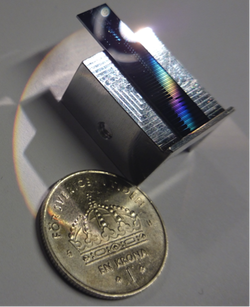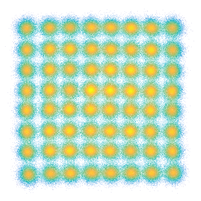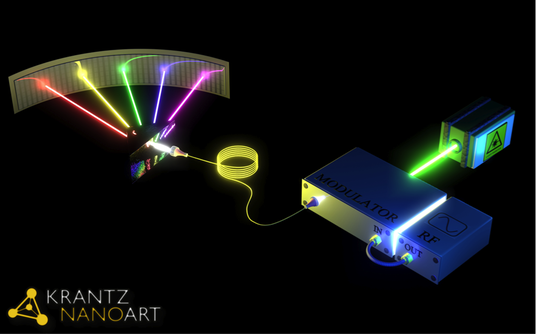Scientific core areas

MICRORESONATOR FREQUENCY COMBS (MICROCOMBS)
Since its realization in 2000, the optical frequency comb has revolutionized the field of optical metrology. To date, most optical frequency combs are based on the so-called mode-locked lasers. These are indeed great tools for many applications, but due to their size and complexity, these devices rarely see use outside of the laboratory. Just a few years ago, a novel type of frequency comb generator was discovered. It is based on a tiny photonic chip that is fabricated by leveraging existing micro and nanotechnology equipment formerly developed by the semiconductor industry. This has an enormous potential in terms of size, cost and reproducibility.
Our goal is to unveil the intricate mechanisms that govern the comb generation process in this novel platform and exploit this light source as a resource for the next generation of optical communication systems.
Since its realization in 2000, the optical frequency comb has revolutionized the field of optical metrology. To date, most optical frequency combs are based on the so-called mode-locked lasers. These are indeed great tools for many applications, but due to their size and complexity, these devices rarely see use outside of the laboratory. Just a few years ago, a novel type of frequency comb generator was discovered. It is based on a tiny photonic chip that is fabricated by leveraging existing micro and nanotechnology equipment formerly developed by the semiconductor industry. This has an enormous potential in terms of size, cost and reproducibility.
Our goal is to unveil the intricate mechanisms that govern the comb generation process in this novel platform and exploit this light source as a resource for the next generation of optical communication systems.

NONLINEAR SILICON PHOTONICS
Silicon photonics is an emerging research area that capitalizes on the investment realized by the semiconductor industry during the last decades. It leverages the existing technology to realize novel chips where the information is carried out by both photons and electrons. It has the potential to revolutionize the Information and Telecommunication industry, from optical interconnects to supercomputers, by providing cheaper, faster and more energetically efficient chips.
The silicon photonic chips are patterned with nanometre precision. This provides a fundamentally new scenario, where the light interacts with the matter in a strongly nonlinear manner. We focus on engineering devices by fostering this interaction with ultrashort laser pulses.
Silicon photonics is an emerging research area that capitalizes on the investment realized by the semiconductor industry during the last decades. It leverages the existing technology to realize novel chips where the information is carried out by both photons and electrons. It has the potential to revolutionize the Information and Telecommunication industry, from optical interconnects to supercomputers, by providing cheaper, faster and more energetically efficient chips.
The silicon photonic chips are patterned with nanometre precision. This provides a fundamentally new scenario, where the light interacts with the matter in a strongly nonlinear manner. We focus on engineering devices by fostering this interaction with ultrashort laser pulses.

BROADBAND COHERENT COMMUNICATIONS
In modern wavelength division multiplexed (WDM) optical communications systems, individual optical carriers are modulated with advanced modulation formats. Information is encoded by leveraging the physical degrees of freedom of the light source (namely amplitude, phase and polarization) and, in the future, the space dimension in the transmission fiber. This scenario brings up tremendous challenges, since there is a need to synthesize and measure complex optical waveforms at ultrafast speeds.
We are developing frequency comb sources with a performance suited to meet these strong demands.
In modern wavelength division multiplexed (WDM) optical communications systems, individual optical carriers are modulated with advanced modulation formats. Information is encoded by leveraging the physical degrees of freedom of the light source (namely amplitude, phase and polarization) and, in the future, the space dimension in the transmission fiber. This scenario brings up tremendous challenges, since there is a need to synthesize and measure complex optical waveforms at ultrafast speeds.
We are developing frequency comb sources with a performance suited to meet these strong demands.

ULTRAFAST FREQUENCY-COMB-BASED METROLOGY
The outstanding phase-noise performance of optical frequency combs has led to a revolution in optical synthesis and metrology, covering a myriad of applications, from molecular spectroscopy to optical clocks. However, the ideal characteristics of an optical frequency comb are application dependent.
This projects exploits the compactness, robustness and flexibility of high-repetition-rate electro-optic comb generators for applications in laser ranging and ultrafast microscopy.
The outstanding phase-noise performance of optical frequency combs has led to a revolution in optical synthesis and metrology, covering a myriad of applications, from molecular spectroscopy to optical clocks. However, the ideal characteristics of an optical frequency comb are application dependent.
This projects exploits the compactness, robustness and flexibility of high-repetition-rate electro-optic comb generators for applications in laser ranging and ultrafast microscopy.